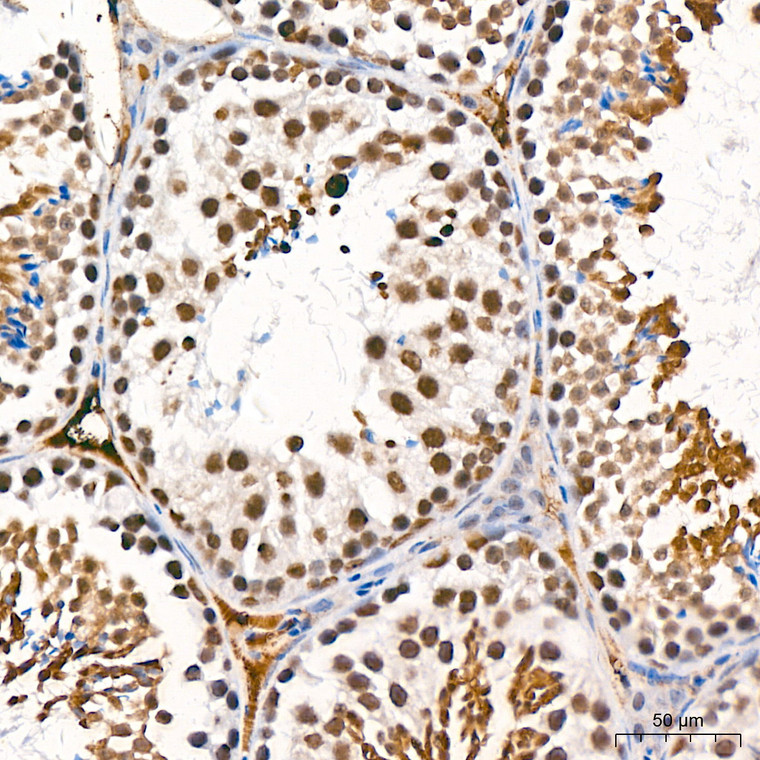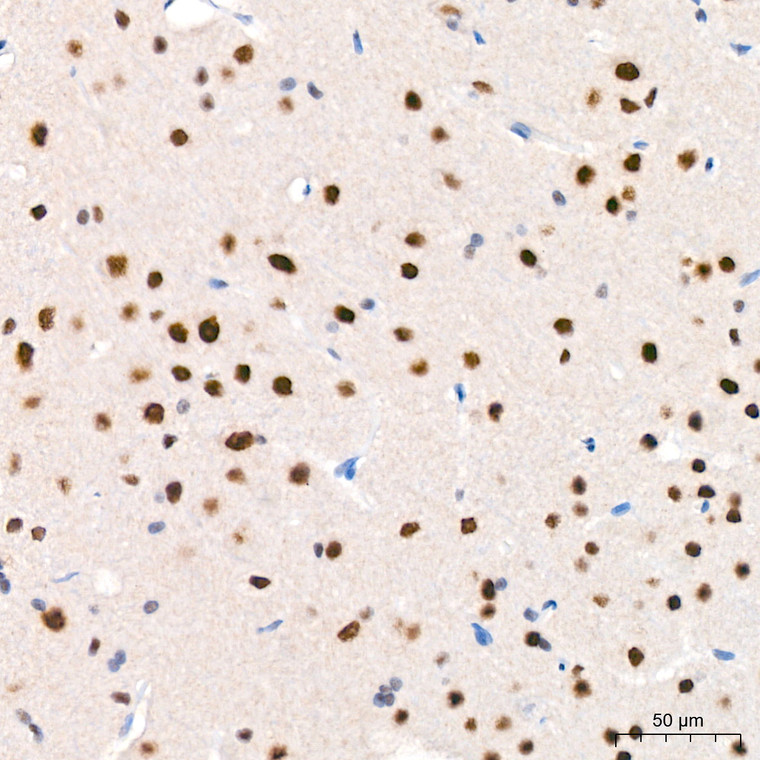| Host: |
Rabbit |
| Applications: |
WB/IHC |
| Reactivity: |
Human/Mouse/Rat |
| Note: |
STRICTLY FOR FURTHER SCIENTIFIC RESEARCH USE ONLY (RUO). MUST NOT TO BE USED IN DIAGNOSTIC OR THERAPEUTIC APPLICATIONS. |
| Short Description: |
Rabbit monoclonal antibody anti-HAUSP/USP7 (100-200) is suitable for use in Western Blot and Immunohistochemistry research applications. |
| Clonality: |
Monoclonal |
| Clone ID: |
S1MR |
| Conjugation: |
Unconjugated |
| Isotype: |
IgG |
| Formulation: |
PBS with 0.02% Sodium Azide, 0.05% BSA, 50% Glycerol, pH7.3. |
| Purification: |
Affinity purification |
| Dilution Range: |
WB 1:500-1:1000 IHC-P 1:50-1:200 |
| Storage Instruction: |
Store at-20°C for up to 1 year from the date of receipt, and avoid repeat freeze-thaw cycles. |
| Gene Symbol: |
USP7 |
| Gene ID: |
7874 |
| Uniprot ID: |
UBP7_HUMAN |
| Immunogen Region: |
100-200 |
| Immunogen: |
Recombinant fusion protein containing a sequence corresponding to amino acids 100-200 of human USP7/HAUSP (Q93009). |
| Immunogen Sequence: |
MVMPRFYPDRPHQKSVGFFL QCNAESDSTSWSCHAQAVLK IINYRDDEKSFSRRISHLFF HKENDWGFSNFMAWSEVTDP EKGFIDDDKVTFEVFVQADA P |
| Tissue Specificity | Expressed in neural progenitor cells (at protein level). Widely expressed. Overexpressed in prostate cancer. |
| Post Translational Modifications | Isoform 1: Phosphorylated. Isoform 1 is phosphorylated at positions Ser-18 and Ser-963. Isoform 2: Not phosphorylated. Isoform 1: Polyneddylated. Isoform 2: Not Polyneddylated. Isoform 1 and isoform 2: Not sumoylated. Isoform 1 and isoform 2: Polyubiquitinated by herpesvirus 1 trans-acting transcriptional protein ICP0/VMW110.leading to its subsequent proteasomal degradation. Isoform 1: Ubiquitinated at Lys-869. |
| Function | Hydrolase that deubiquitinates target proteins such as FOXO4, DEPTOR, KAT5, p53/TP53, MDM2, ERCC6, DNMT1, UHRF1, PTEN, KMT2E/MLL5 and DAXX. Together with DAXX, prevents MDM2 self-ubiquitination and enhances the E3 ligase activity of MDM2 towards p53/TP53, thereby promoting p53/TP53 ubiquitination and proteasomal degradation. Deubiquitinates p53/TP53, preventing degradation of p53/TP53, and enhances p53/TP53-dependent transcription regulation, cell growth repression and apoptosis. Deubiquitinates p53/TP53 and MDM2 and strongly stabilizes p53/TP53 even in the presence of excess MDM2, and also induces p53/TP53-dependent cell growth repression and apoptosis. Deubiquitination of FOXO4 in presence of hydrogen peroxide is not dependent on p53/TP53 and inhibits FOXO4-induced transcriptional activity. In association with DAXX, is involved in the deubiquitination and translocation of PTEN from the nucleus to the cytoplasm, both processes that are counteracted by PML. Deubiquitinates KMT2E/MLL5 preventing KMT2E/MLL5 proteasomal-mediated degradation. Involved in cell proliferation during early embryonic development. Involved in transcription-coupled nucleotide excision repair (TC-NER) in response to UV damage: recruited to DNA damage sites following interaction with KIAA1530/UVSSA and promotes deubiquitination of ERCC6, preventing UV-induced degradation of ERCC6. Involved in maintenance of DNA methylation via its interaction with UHRF1 and DNMT1: acts by mediating deubiquitination of UHRF1 and DNMT1, preventing their degradation and promoting DNA methylation by DNMT1. Deubiquitinates alkylation repair enzyme ALKBH3. OTUD4 recruits USP7 and USP9X to stabilize ALKBH3, thereby promoting the repair of alkylated DNA lesions. Acts as a chromatin regulator via its association with the Polycomb group (PcG) multiprotein PRC1-like complex.may act by deubiquitinating components of the PRC1-like complex. Able to mediate deubiquitination of histone H2B.it is however unsure whether this activity takes place in vivo. Exhibits a preference towards 'Lys-48'-linked ubiquitin chains. Increases regulatory T-cells (Treg) suppressive capacity by deubiquitinating and stabilizing the transcription factor FOXP3 which is crucial for Treg cell function. Plays a role in the maintenance of the circadian clock periodicity via deubiquitination and stabilization of the CRY1 and CRY2 proteins. Deubiquitinates REST, thereby stabilizing REST and promoting the maintenance of neural progenitor cells. Deubiquitinates SIRT7, inhibiting SIRT7 histone deacetylase activity and regulating gluconeogenesis. Involved in the regulation of WASH-dependent actin polymerization at the surface of endosomes and the regulation of endosomal protein recycling. It maintains optimal WASH complex activity and precise F-actin levels via deubiquitination of TRIM27 and WASHC1. Mediates the deubiquitination of phosphorylated DEPTOR, promoting its stability and leading to decreased mTORC1 signaling. (Microbial infection) Contributes to the overall stabilization and trans-activation capability of the herpesvirus 1 trans-acting transcriptional protein ICP0/VMW110 during HSV-1 infection. (Microbial infection) Upon infection with Epstein-Barr virus, the interaction with viral EBNA1 increases the association of USP7 with PML proteins, which is required for the polyubiquitylation and degradation of PML. |
| Protein Name | Ubiquitin Carboxyl-Terminal Hydrolase 7Deubiquitinating Enzyme 7Herpesvirus-Associated Ubiquitin-Specific ProteaseUbiquitin Thioesterase 7Ubiquitin-Specific-Processing Protease 7 |
| Database Links | Reactome: R-HSA-5689880Reactome: R-HSA-6781823Reactome: R-HSA-6781827Reactome: R-HSA-6782135Reactome: R-HSA-6782210Reactome: R-HSA-6804757Reactome: R-HSA-8866652Reactome: R-HSA-8948747 |
| Cellular Localisation | NucleusCytoplasmPml BodyChromosomePresent In A Minority Of Nd10 Nuclear BodiesAssociation With Icp0/Vmw110 At Early Times Of Infection Leads To An Increased Proportion Of Usp7-Containing Nd10Colocalizes With Atxn1 In The NucleusColocalized With Daxx In Speckled StructuresColocalized With Pml And Pten In Promyelocytic Leukemia Protein (Pml) Nuclear Bodies |
| Alternative Antibody Names | Anti-Ubiquitin Carboxyl-Terminal Hydrolase 7 antibodyAnti-Deubiquitinating Enzyme 7 antibodyAnti-Herpesvirus-Associated Ubiquitin-Specific Protease antibodyAnti-Ubiquitin Thioesterase 7 antibodyAnti-Ubiquitin-Specific-Processing Protease 7 antibodyAnti-USP7 antibodyAnti-HAUSP antibody |
Information sourced from Uniprot.org
12 months for antibodies. 6 months for ELISA Kits. Please see website T&Cs for further guidance















